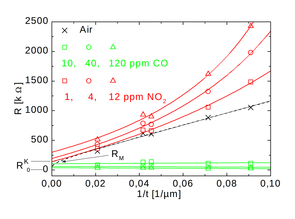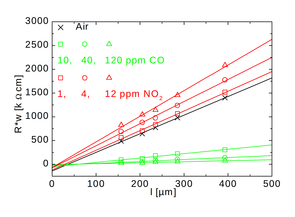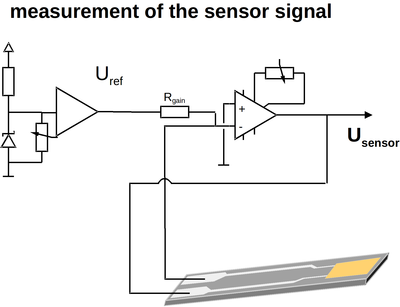DC Resistance Measurements
 |
 |
The typical measurement technique for semiconducting metal oxide material (MOX) sensors is the one of their conductance or resistance; in fact, in almost all cases it is the resistance/conductance of the sensors, which is linked to the composition of the surrounding atmosphere that is used for gaining the desired chemical information.
The measurements are performed in different modes of operation, spanning form constant operation temperature and permanent polarization to modulated operation temperature and periodic dc tests.
Whatever conditions are used, one has to understand what is measured and how the measurement conditions will influence their results. Not only the transduction of the surface reaction, in terms of the change in the resistance of the sensor is measurable, even the measurement conditions will alter the resistance of a sensor in an ambient atmosphere. One has to be aware of the well accepted image of the resistance of the sensitive layer being dominated by the gas-dependent grain-grain potential barriers to be, probably, over-simplified. The contribution of the gas sensing process to the overall resistance of the sensor depends not only on the gas sensing material properties, but also on various sensor characteristics such as the sensitive layer morphology, electrode parameters, etc.
Another parameter which should not be underestimated is the effect of a series of potential barriers in regard to the measurement parameters, more precisely on the measurement current/voltage; the potential drop will be distributed over the different series resistances in the layer and will be concentrated on the high resistive elements. In literature these dependencies are reported as "polarization effects" or "varistor" effects and these effects are responsible for the problems while measuring with multimeters in auto-range mode.
Besides these electronic effects, one should consider also the chemical ones, which might be influenced/determined by the nature of the electrodes and different polarizations. But even the chemical problem of the conversion of the reactive gas (CO, NO2, CxHy,...) into an inert species (CO2, H2O, N2,...) gives uncertainties related to the distribution of the gaseous atmosphere in the sensing layer.
To get insight into the role of the contacts, transmission line measurements (TLM) are quite useful. In these experiments one uses substrates with different geometric parameters. The sensor resistance is plotted as a function of the spacing between the electrodes for different ambient conditions and therefore the role of the metal-oxide/metal contact can be seen.
 |
Related References
nvestigation of CO/CH4 mixtures measured with differently doped SnO2 sensors, S. Hahn, N. Barsan, U. Weimar, Sensors and Actuators B, 78, 2001, 64-68.
State of the Art of Gas Sensors - MOX Sensors as a Working Example, J. Kappler, N. Barsan, U. Weimar, Photoelectronics B, 10, 2001, 3-5.
Conduction Model of Metal Oxide Gas Sensors, N. Barsan and U. Weimar, Journal of Electroceramics, 7, 2001, 143-167.
Understanding the fundamental principles of metal oxide based gas sensors; the example of CO sensing with SnO2 sensors in the presence of humidity, N. Barsan and U. Weimar, J. Phys. Condens. Matter, 15, 2003, R813-R83.
CO sensing with SnO2 thick film sensors: role of oxygen and water vapour, S. Hahn, N. Barsan, U. Weimar, S.G. Ejakov, H.J. Visser, R.E. Soltis,, Thin Solid Films, 436, 2003, 17-24.
Polycrystalline Well-Shaped Blocks of Indium Oxide Obtained by the Sol-Gel Method and Their Gas-Sensing Properties, A. Gurlo, N. Barsan, U. Weimar, M. Ivanovskaya, A. Taurino and P. Siciliano, Chem. Mater., 15, 2003, 4377-4383.
Flame spray synthesis of tin dioxide nanoparticles for gas sensing, T.Sahm, L.Mädler, A.Gurlo, N.Barsan, S.E. Pratsinis, U.Weimar, Sensors and Actuators B, 98, 2004, 148-153.
TaON and Ta3N5 thin films: a new class of gas sensors, O. Merdrignac-Conanec, M. Kerlau, M. Guilloux-Viry, R. Marchand, N. Barsan, U. Weimar, Silicates Industriels, 69, 2004, 141-145.
Sensing low concentrations of CO using flame-spray made Pt/SnO2 nanoparticles, L. Mädler, T. Sahm, A. Gurlo, J.D. Grunwaldt, N. Barsan, U. Weimar and S.E. Pratsinis, J. Nanoparticle Res., 8, 2006, 783-796.
Template-free synthesis and assembly of single-crystalline tungsten oxide nanowires and their gas-sensing properties, J. Polleux, A. Gurlo, N. Barsan, U. Weimar, M. Antonietti and M. Niederberger, Angewandte Chemie, 44, 2005, 1-6.
Preparation and characterization of gallium (oxy)nitride powders. Preliminary investigation as new gas sensor materials, M. Kerlau, O. Merdrignac-Conanec, P. Reichel, N. Barsan, U. Weimar, Sensors and Actuators B, 115, 2006, 4-11.
Detection of propane by "GaON" thick-film gas sensors, M. Kerlau, P. Reichel, N. Barsan, U. Weimar, S. Delsarte-Guéguen and O. Merdrignac-Conanec, Sensors and Actuators B, 122, 2007, 14-19.
Gas sensors based on semiconducting metal oxides, A.Gurlo, N.Barsan, U.Weimar, Metal Oxides: Chemistry and Applications, Marcel Dekker, New York, 2004.
Metal oxide based gas sensor research: how to?, N. Barsan, D. Koziej and U. Weimar, Sensors & Actuators B,, 121, 2007, 18-35.